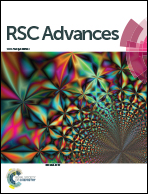Bis-naphthalimides bridged by electron acceptors: optical and self-assembly characteristics†
Abstract
The self-assembly of small organic molecules into molecular stacks plays a vital role in the construction of stable supramolecular structures. The self-assembly of highly linear and rigid naphthalimide-based electron deficient small molecules, which are synthesized via a Pd-catalyzed Sonogashira cross coupling reaction, leads to the formation of controlled morphologies and well-defined nanostructures, which are developed from the J-aggregated solid state packing mode. Their optical properties evidence the molecular self-aggregation in solution and the solid state. Fluorescence lifetime decay measurements for the monomeric and aggregated state of the dyes demonstrate the effect of aggregation on the radiative and non-radiative decay rates. Electrochemical studies reveal that these electron deficient compounds possess suitable energy levels for them to be used as airstable n-type semiconductors. The electronic features and coplanar arrangement of the functional entities, which were determined via density functional theoretical computations, ensure a close packing arrangement of molecules in the solid state. Field emission scanning electron microscopy was used to unravel the nanostructure formation of the as synthesized samples and those obtained from different solvents. The formation of one-dimensional (1D) to three dimensional (3D) nano to micro-scale fibers, rods, cubes or flower-like structures is attributed to the non-covalent π–π intermolecular stacking of the aromatic moieties and packing of the hydrophobic alkyl chains. Dynamic light scattering studies reveal the nanoscale dimension of the aggregates. Fluorescence images of the compounds were observed under an optical fluorescence microscope, which exhibit multicolor emission under different light sources. Furthermore, thermal analysis and powder X-ray diffraction characterization of the small molecules indicate high thermal stability, crystallinity and effective π–π interplanar morphology. The present study demonstrates the use of intermolecular interactions to achieve organized nanostructure designs with different morphologies and sizes.


 Please wait while we load your content...
Please wait while we load your content...